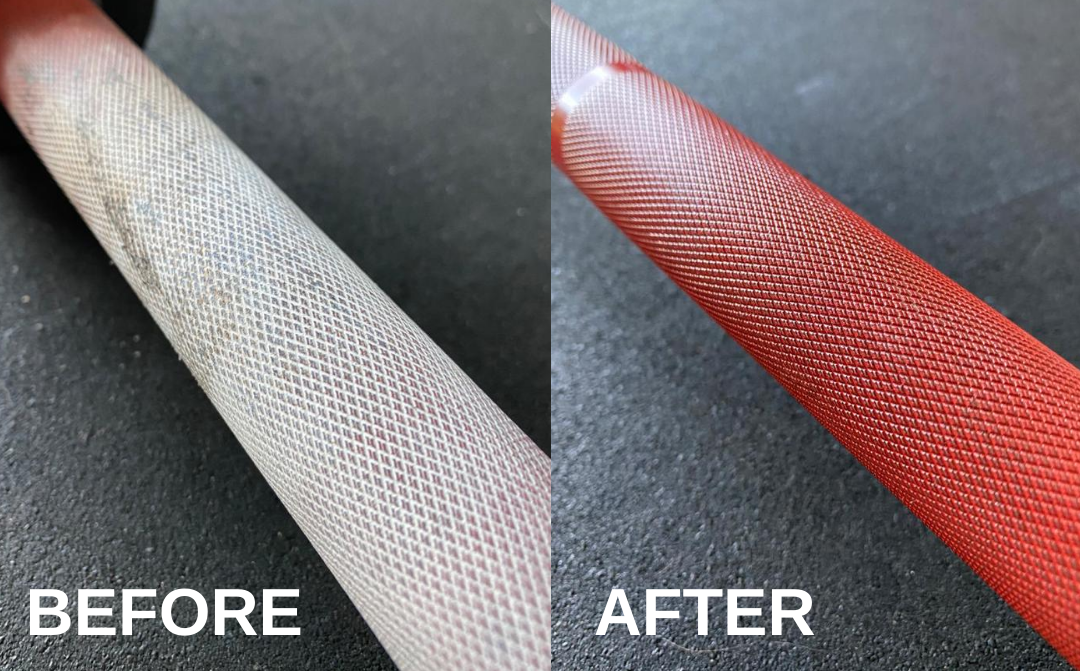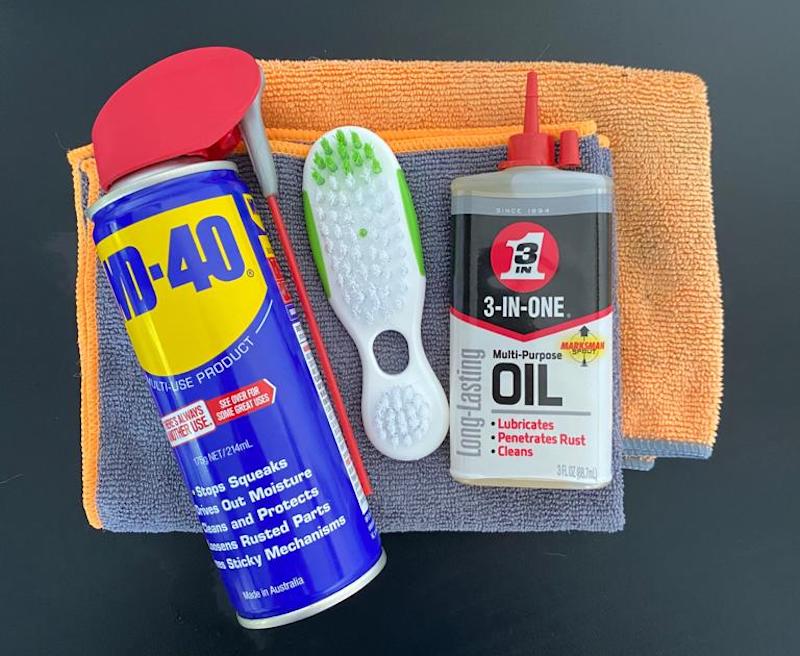How to Maintain your Barbell
When it comes to barbell maintenance, many home gym and commercial gym owners struggle to know what to do or how to best clean and maintain their Barbell. From consistent use, the bar can be exposed to many elements including sweat, skin, gym chalk and more, which can build up and hinder the longevity of the barbell.
If you own and love your Barbell, its best that you regularly clean and maintain it so it lasts forever. Here’s how!
How Often Should Maintenance be Done?
Commercial Gyms:
If your bar/s are used in commercial gym setting then generally speaking, the barbells use is going to be a lot higher than that of a home garage user, making it much more beneficial to maintain the Barbell more regularly. Regardless of the finish on the bar, we recommend a fortnightly, or at minimum monthly maintenance clean and check.
Home Gyms:
As for the home gym owners, the bar will most likely not need to be cleaned as regularly to that of a commercial gym, depending on the usage of course. For bars that are Cerakote, Stainless Steel or Hard Chrome, you can go extended periods without cleaning them, however, you will still have to regularly lubricate the bushings and bearings if you want the sleeves to spin freely. For bars that are bare steel, black Oxide or zinc, complete maintenance should be performed fortnightly, or monthly at a minimum.

Barbell Maintenance
Barbell maintenance consist of four things; using the correct maintenance supplies, cleaning the knurling, wiping down the bar and lubricating the bushings and bearings.
Maintenance Supplies:
Before cleaning or performing maintenance on the bar, make sure that you have the correct supplies for doing so. Using the wrong materials can actually damage the bar’s finish, causing oxidation to occur.
The Supplies You’ll Need:
- Stiff, nylon brush. However if the bar is hard chrome or stainless steel, use a stainless brush. If brushing a stainless steel bar use a new stainless brush that has not been used on carbon steel to avoid carbon steel contaminating the stainless steel bar.
- 3-In-One oil
- A rag that will be used to apply oil to the bar
- A rag for cleaning oil off the bar
Step 1: Cleaning the Knurling
Before oiling the bar, you should clean the knurling. Leaving debris in the knurl, such as left over chalk or dirt from your hands, can cause the bar to rust over time.
- Apply a small amount of oil to the bar’s knurling.
- Use the brush to clean chalk and dirt out of the knurl.
Step 2: Wipe the Bar Down With Oil
Wiping down the bar with oil will help remove rust and protect the bar. If you want your bar to last a long time, this will be necessary. Especially if it’s being used in a commercial gym, which is often times an extremely harsh environment for a barbell.
- Apply a small amount of oil to the rag and wipe down the barbell with it.
- Use the brush to work the oil into the knurling.
- Let the oil on the bar dry for a few minutes.
- Use the clean rag to wipe down the bar, cleaning up any excess oil.
Step 3: Lubricate the Bushings or Bearings
If you want the sleeves of your bar to continue spinning smoothly, you’ll have to regularly lubricate its bushings or bearings.
- Stand the bar upright, or vertically.
- With the bar standing straight up, apply a conservative amount of oil (a few drops) to the beginning, or inside, of the sleeve closest to the floor, where it meets the shaft. Slowly spin the sleeve while doing so to allow the lubricant to reach the entire bushing or bearing.
- Use the cleaning rag to wipe up any excess oil.
- Flip the bar so that the other end is facing up, and repeat steps 2-3 for the other sleeve.

Other Maintenance Tips
Avoid Doing Rack Pulls
Another tip to help sustain a long lasting relationship with your barbell is to avoid doing exercises that can be destructive to the bar, such as rack pulls. These types of exercises can cause a bar to permanently bend. If doing them can’t be avoided, it’s best to use a cheap bar that you don’t care too much about.
Leave the Bar Lying Flat
When storing the bar, it’s best to leave it lying flat, as opposed to vertical. This will help prevent chalk from sliding into the bar’s sleeve assembly, which could prevent the bushings or bearings from spinning smoothly.
How to Maintain your Barbell
When it comes to barbell maintenance, many home gym and commercial gym owners struggle to know what to do or how to best clean and maintain their Barbell. From consistent use, the bar can be exposed to many elements including sweat, skin, gym chalk and more, which can build up and hinder the longevity of the barbell.
If you own and love your Barbell, its best that you regularly clean and maintain it so it lasts forever. Here’s how!
How Often Should Maintenance be Done?
Commercial Gyms:
If your bar/s are used in commercial gym setting then generally speaking, the barbells use is going to be a lot higher than that of a home garage user, making it much more beneficial to maintain the Barbell more regularly. Regardless of the finish on the bar, we recommend a fortnightly, or at minimum monthly maintenance clean and check.
Home Gyms:
As for the home gym owners, the bar will most likely not need to be cleaned as regularly to that of a commercial gym, depending on the usage of course. For bars that are Cerakote, Stainless Steel or Hard Chrome, you can go extended periods without cleaning them, however, you will still have to regularly lubricate the bushings and bearings if you want the sleeves to spin freely. For bars that are bare steel, black Oxide or zinc, complete maintenance should be performed fortnightly, or monthly at a minimum.

Barbell Maintenance
Barbell maintenance consist of four things; using the correct maintenance supplies, cleaning the knurling, wiping down the bar and lubricating the bushings and bearings.
Maintenance Supplies:
Before cleaning or performing maintenance on the bar, make sure that you have the correct supplies for doing so. Using the wrong materials can actually damage the bar’s finish, causing oxidation to occur.
The Supplies You’ll Need:
- Stiff, nylon brush. However if the bar is hard chrome or stainless steel, use a stainless brush. If brushing a stainless steel bar use a new stainless brush that has not been used on carbon steel to avoid carbon steel contaminating the stainless steel bar.
- 3-In-One oil
- A rag that will be used to apply oil to the bar
- A rag for cleaning oil off the bar
Step 1: Cleaning the Knurling
Before oiling the bar, you should clean the knurling. Leaving debris in the knurl, such as left over chalk or dirt from your hands, can cause the bar to rust over time.
- Apply a small amount of oil to the bar’s knurling.
- Use the brush to clean chalk and dirt out of the knurl.
Step 2: Wipe the Bar Down With Oil
Wiping down the bar with oil will help remove rust and protect the bar. If you want your bar to last a long time, this will be necessary. Especially if it’s being used in a commercial gym, which is often times an extremely harsh environment for a barbell.
- Apply a small amount of oil to the rag and wipe down the barbell with it.
- Use the brush to work the oil into the knurling.
- Let the oil on the bar dry for a few minutes.
- Use the clean rag to wipe down the bar, cleaning up any excess oil.
Step 3: Lubricate the Bushings or Bearings
If you want the sleeves of your bar to continue spinning smoothly, you’ll have to regularly lubricate its bushings or bearings.
- Stand the bar upright, or vertically.
- With the bar standing straight up, apply a conservative amount of oil (a few drops) to the beginning, or inside, of the sleeve closest to the floor, where it meets the shaft. Slowly spin the sleeve while doing so to allow the lubricant to reach the entire bushing or bearing.
- Use the cleaning rag to wipe up any excess oil.
- Flip the bar so that the other end is facing up, and repeat steps 2-3 for the other sleeve.

Other Maintenance Tips
Avoid Doing Rack Pulls
Another tip to help sustain a long lasting relationship with your barbell is to avoid doing exercises that can be destructive to the bar, such as rack pulls. These types of exercises can cause a bar to permanently bend. If doing them can’t be avoided, it’s best to use a cheap bar that you don’t care too much about.
Leave the Bar Lying Flat
When storing the bar, it’s best to leave it lying flat, as opposed to vertical. This will help prevent chalk from sliding into the bar’s sleeve assembly, which could prevent the bushings or bearings from spinning smoothly.


























